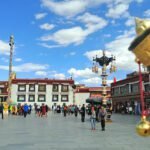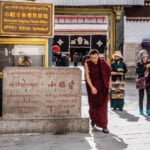Youning Temple, also known as Guolong Temple, holds significant historical and religious importance in the region. It served as a crucial passage connecting Tibet to Inner Mongolia via Qinghai during the Ming and Qing Dynasties. The temple attracted a diverse range of believers from different ethnic backgrounds, including the Tu, Tibetan, Mongolian, and Han people, all of whom followed Tibetan Buddhism.
Nestled on the slopes of Daban Mountain, Youning Temple holds a unique position among the Buddhist temples in Qinghai. It gained prominence due to the presence of renowned monks and the esteemed religious status of the five living Buddhas, notably Changkya. Its historical significance was such that it overshadowed even the renowned Ta’er Temple, earning the title of “The Mother of Monasteries in Huangbei.” The grandeur and splendour that once defined the temple’s scale in history were unparalleled.
Youning Temple during Cultural Revolution
Unfortunately, the temple faced severe destruction during the Cultural Revolution, marking its third time being ravaged. Despite the efforts to restore the three halls, the current scale of the temple falls far short of its former glory. Tragically, most of the cultural relics that once adorned its halls have been lost to time. Despite these setbacks, Youning Temple continues to attract scholars and researchers from both domestic and international backgrounds.
They are driven by an insatiable curiosity to uncover the temple’s rich history and explore the remnants of its once majestic architecture. Every visit is an opportunity to delve into the fascinating stories of the temple’s past, to unravel the spiritual significance it held for countless devotees throughout the centuries. As one wanders through the restored halls of Youning Temple, a bittersweet ambience fills the air. The echoes of prayers and chants that once resonated within its walls seem to seep through time, a poignant reminder of the temple’s former glory. Though the cultural relics may have vanished, the spiritual aura perseveres, drawing visitors into a mystical realm of ancient beliefs and profound devotion.
The destruction suffered by Youning Temple during the Cultural Revolution stands as a testament to the resilience of faith and the enduring importance of preserving history. Efforts must continue in safeguarding what remains and share the temple’s remarkable story with the world. By doing so, we honour the memories of those who once found solace within its hallowed halls and pay homage to the rich tapestry of cultures that flourished within the temple’s embrace.













